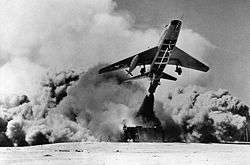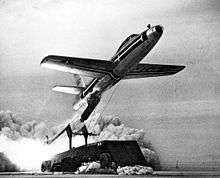Zero-length launch

The zero-length launch system or zero-length take-off system (ZLL, ZLTO, ZEL, ZELL) was a system whereby jet fighters and attack aircraft were intended to be placed on rockets attached to mobile launch platforms. Most zero length launch experiments took place in the 1950s, during the Cold War.
History
The primary advantage of a zero-length launch system is the elimination of the need for a vulnerable airfield for takeoffs. In the event of a sudden attack, air forces could field effective air defenses and launch airstrikes even with their own airbases destroyed. Although launching aircraft using rocket boosters proved to be relatively trouble-free, zero length launch systems still required a conventional runway if the aircraft was expected to land. Bulky mobile launching platforms also proved to be expensive to operate and difficult to transport. Security would also have been an issue with mobile launchers, especially if equipped with nuclear-armed strike fighters.
The United States Air Force, the Bundeswehr's Luftwaffe, and the Soviets' VVS all conducted experiments in zero-length launching. The first manned aircraft to be ZELL-launched was an F-84G in 1955.[1] The Soviets' main interest in ZELL was for point defense-format protection of airfields and critical targets using MiG-19s. The American tests with the F-84s started with using the Martin MGM-1 Matador solid-fuel boost motor of some 240 kilonewton (52,000 lbf) thrust output, which burned out in only seconds after ignition, dropping away from the manned fighter only a second or two later - the larger F-100 Super Sabre and MiG-19 "Farmer" tests used similar short-burn solid fueled boost motors, of much more powerful 600 kN (135,000 lbf) thrust-class output levels.[2] All works upon ZELL aircraft were abandoned due to logistical concerns and the increasing efficiency of guided missiles.
Manned aircraft involved in ZELL testing


- Republic F-84G Thunderjet
- North American F-100D Super Sabre
- Lockheed F-104 Starfighter
- Mikoyan-Gurevich MiG-19 SM-30 "Farmer"
- North American XF-108 Rapier - (aircraft program cancelled)
- Avro Canada CF-105 Arrow - (aircraft program cancelled)
The desire to field combat aircraft without depending on vulnerable landing strips also motivated development of aircraft capable of vertical (VTOL) or short (STOL) takeoffs or landings. Examples of these include British Hawker Siddeley Harrier, Soviet Yak-38 (both serially produced) and American McDonnell Douglas F-15 STOL/MTD.
See also
- Bachem Ba 349 World War II vertical launch rocket interceptor
References and notes
- ↑ "Fighter Plane Launched Like Missile From Truck Platform." Popular Mechanics, March 1955, p. 108.
- ↑ Greg Goebel's Air Vectors' "The Zero-Length Launch Fighter" page
External links
- "The Zero-Length Launch Fighter". Greg Goebel's AIR VECTORS. Archived from the original on June 13, 2012.
- "Martin Matador and Mace missiles". 38th Tactical Missile Wing, tribute site.
- "Cape Canaveral Air Force Station. Launch Complex 21". 2 June 2008. Recent photos (out of use, but well preserved) of the hard-site test buildings for Mace
- Video of MiG-19 performing a ZELL-style launch